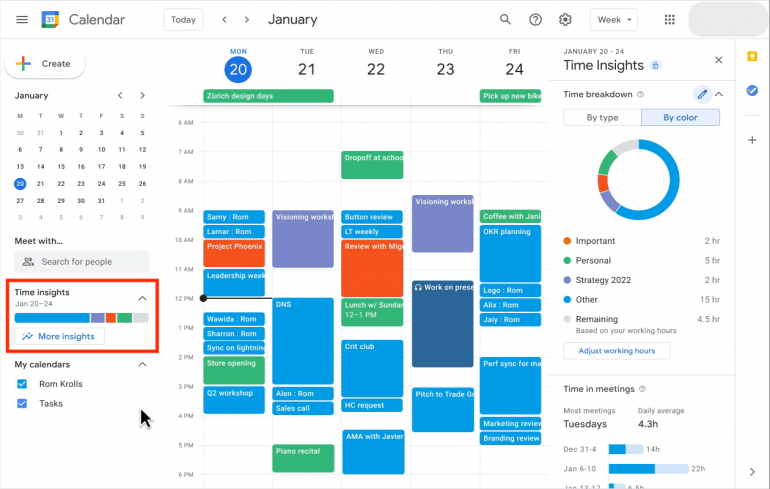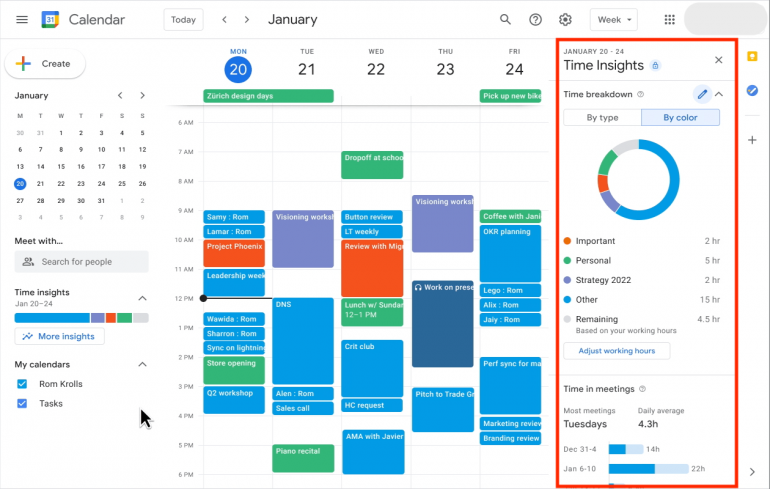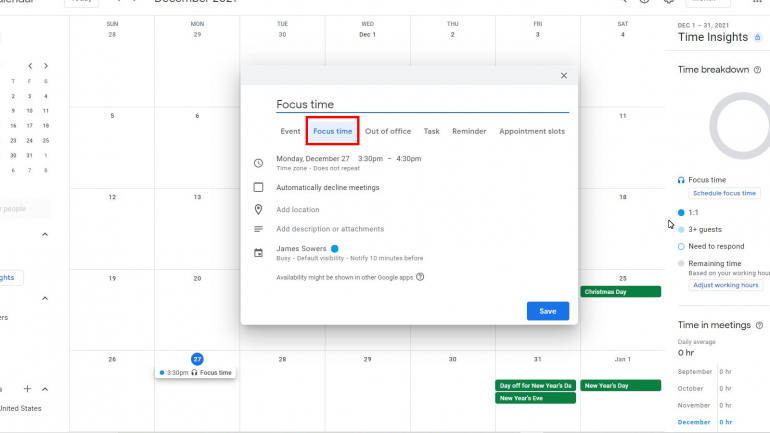Google Calendar Time Insights: A Comprehensive Guide
 Image: Gaining Visuals
Image: Gaining Visuals
How much time do you spend in meetings every week? For many of us, it’s more than we would like to admit. But if you want to know for sure, it’s best to use a dedicated tool, like Google Calendar Time Insights. With the information this feature offers, you can assess whether meetings are occupying too much of your time, and make the necessary adjustments so that you can stay focused, improve your productivity, and enjoy a better work-life balance.
According to this article, 78% of workers believe their meeting schedules are chaotic, with 38% blaming upper management and 16% blaming their direct manager. An incredible 64% of employees are only excited about meetings when they’re well-planned, which isn’t always the case. If left ungoverned, meetings can often become long, tedious and unproductive, pulling people away from completing actual work.
Does this mean that all meetings are pointless? Absolutely not. Some are critical. Others add value, even if they’re not essential. And sometimes it is just nice to have a conversation with and bounce ideas off other humans, especially if you work remotely.
To stay productive and get the most value out of your work, however, it is important to determine how much time you’re spending in meetings, and to know which are important and which, quite literally, could have been an email.
Google Calendar Time Insights can help with this. It’s a simple tool that helps you track meeting times. Let’s take an in-depth look at how it works.
(Want to get some of your questions answered straight away? Simply skip to our frequently asked questions section at the end.)
Table of Contents
TOC
What is Google Calendar Time Insights?
Google Calendar Time Insights is a feature in Google Calendar that tells you how much time you spend in meetings and who you meet with the most.
It’s built into the interface of Google Calendar and is available on most paid Google Workspace and Education plans but not for plans like Business Starter, Enterprise Essentials, Education Fundamentals, Education Standard, and so on. It’s also not available if you only have a personal Google account unfortunately.
Through Time Insights, Google Calendar provides you with valuable meeting-related information, which can help you gain a better understanding of how you spend your time, and optimize your day, your workflow, and your life.
The information on Time Insights is only visible to you, the primary calendar owner. Your Workspace manager doesn’t automatically have access to it. However, you can grant them the ability to see it by adjusting your permissions. This feature is turned on by default, and while Workspace administrators can turn it off, users can only minimize it.
Google Calendar isn’t the first to offer this kind of feature. Android and iOS also let you review your mobile device usage in a similar way. And of course, it’s only really useful if you schedule all of your meetings in Google Calendar. If you don’t, and you also use other calendars such as Microsoft Outlook, another meeting tracking tool, like that offered by Timing, might suit your needs better.
Time Insights is also only available on desktop devices, not mobile, so if you do a lot of your meetings while you’re on the run, you won’t be able to capture this data. (Again, Timing can help you out here.)
How Google Calendar Time Insights works
The Google Calendar Time Insights panel can be found on the left-hand side of your Google Calendar. By default, the Time Insights panel is minimized, but it does feature a handy summary.

Image source: Google Workspace Updates
If you click the “ More insights” button, a larger panel will open on the right-hand side of the app in a sidebar. Here, you’ll find several valuable sets of data.
 Image source: Google Workspace Updates
Image source: Google Workspace Updates
Time breakdown
The most important element in Time Insights is the “time breakdown” pie chart, which shows you how much of your time is spent in meetings. It breaks your meeting time down into categories: meetings between just two people and meetings of three people or more. It will also highlight meetings that you haven’t responded to yet.
If you hover your cursor over one of the pie chart colors, it will dim all events on your calendar except the ones that match that type. This helps you see where those meetings are in your schedule.
According to Google, Calendar entries where you’re the only attendee don’t count towards these meeting totals. So if you schedule time to work on certain projects alone, they won’t disrupt your statistics.
Time in meetings
Next, there’s the “time in meetings” section, which offers a snapshot of your meeting schedule. This tells you which days you have most meetings, your average daily meeting duration, and the total amount of time you spent in meetings over prior equivalent chunks of time. With this information, you can see how much you are currently spending in meetings versus how much you typically spend.
In order to track your meeting times with Time Insights accurately, it is important that every meeting that you attend makes it onto your calendar, including the duration and attendee list. Without these data points, your Time Insights report won’t be entirely accurate. Fortunately, Google Calendar allows you to modify the event details after an event, so you can make some last-minute changes if another person shows up or if the meeting runs longer than planned.
People you meet with
This section shows you who you have the most meetings with over a selected period. You can pin up to 10 people, or Google Calendar will make suggestions. Colored bars indicate whether these meetings are one-on-one or in a group of up to 15 people. If you hover your mouse over time, these meetings will be highlighted on your calendar. If you don’t have a meeting with a pinned person, this section will also show you when your next scheduled meeting with them is.
Focus time
Time Insights also offers a feature called “Focus time.” It appears alongside the standard “Out of office” and “Event” tags when you create a new entry on your calendar. With focus time, you can block off small or large sections of time so that you can really focus on important projects and engage in deep work.
To designate focus time, add a new Calendar entry and use the focus time option. You can customize the entry time’s name, time, color, and other options. Be strong about sticking to this schedule by clicking the box next to “Automatically decline meetings” so meeting organizers know that you aren’t available during this time.
Like all of the Time Insights features, focus time is only available for people with work or school Google accounts.
 Image source: Google Workspace Updates
Image source: Google Workspace Updates
Color categorization
A more recent feature in Google Calendar Time Insights is its color categorization functionality, which makes it easier to categorize your time. Simply name and assign a corresponding color label to any event in Time Insights and you’ll find it easier to track the time you spend on different projects, in certain meetings, or with specific people.
What we like about Time Insights
Our favorite thing about Time Insights is that it makes people aware of their time. Working hard is important, but understanding how you work is equally so. Meetings can easily absorb your time, sometimes to the detriment of your focus and productivity, and a handy widget in an app you use a lot can make sure you’re mindful of your time.
We also like that Time Insights in Google Calendar breaks down meeting times by person. This helps you see who is hogging your time — a manager, maybe, or a particular client — and may help you make adjustments to limit that time.
Finally, we love the focus time feature. Designating portions of your day for uninterrupted work is a critical way to make yourself more productive. It prevents other people from infiltrating periods of deep concentration so you can focus on your revenue-generating activities.
Google Calendar Time Insights limitations
Time Insights is a powerful tool, but it has its limitations.
It is only available to Workspace users
Sadly, Google Calendar Time Insights isn’t part of the free Google Calendar. You must be a user through a business or organization that uses Google Workspace, which isn’t free.
However, if you do decide to use Google Workspace, it offers a number of benefits you might find helpful for your work. All Google Workspace plans include a custom email for your business, for example, as well as access to collaboration tools like Gmail, Calendar, Meet, Chat, Drive, Docs, Sheets, Slides, Forms, Sites, and more. Plans start at $6/month for one person.
You have to schedule every meeting
Time Insights only knows you are in a meeting if you tell it you are. The meeting must be in your Google Calendar. This means that if you join or host an impromptu meeting, you will need to go back and add it retroactively to your calendar in order for Time Insights to add it to its calculation. This can be challenging if you tend to join a lot of last-minute meetings.
It’s not a complete time-tracking solution
Don’t mistake Google Calendar Time Insights as a substitute for tracking your time. It only tracks the time you spend in meetings. It doesn’t track anything else. If you spend a majority of your time in meetings, or if that is all you care to track, then it offers some value. But if you perform many tasks throughout the day and want to optimize the way you spend your time, Time Insights leaves a lot to be desired.
You must use Google Calendar
Time Insights is an extended feature of Google Calendar. It is not available as a standalone app. If you prefer not to use Google Calendar for your scheduling, or you use multiple calendars depending on the clients you work with, then Time Insights won’t be very useful.
![]() Image source: LinkedIn Sales Solutions
Image source: LinkedIn Sales Solutions
Getting Accurate Meeting Time Data: Beyond Scheduled Duration
Google Calendar Time Insights is helpful, but it reports scheduled meeting time, not what actually happened. In reality, meetings often end early, run long, or get canceled, which can skew your picture of where the day went.
If you need precise meeting data for billing, productivity, or work-life balance, that difference matters. Timing fills the gap by detecting when calls start and end in popular meeting apps and then prompting you to categorize the real duration once the call finishes. This way you record what happened, not just what was on the calendar. Learn more about how this works in Timing’s meeting tracking.
Beyond single calls, Timing can also add up recurring meetings with similar titles over time, helping you spot your most common meeting types and biggest time sinks – insight that Google Calendar’s Time Insights doesn’t provide on its own. That way, you don’t just see “four hours of meetings on Tuesday,” but how that time breaks down across clients, projects, or meeting types with actual durations.
How to track all your time and never miss a meeting
If you need more accurate information to track your time in meetings (or to track your time altogether), you might be in the market for a true time-tracking app, like Timing.
Timing automatically calculates the time you spend in various apps, including granular detail about specific documents you work on, websites you visit, and meetings you attend. You can manually or automatically sort your activities into categories for projects and clients. There’s no need to press “record” or “stop” at any time. Just keep focusing on your work while Timing records your time in the background, then review your time once you’re done.
Timing means never having to worry about inaccurate timesheets. Instead, you’ll know exactly what you worked on at any given time. If your client or partner needs to see a timesheet for billing, you can simply export a report from Timing with the click of a button.
![]() When it comes to tracking meeting times, Timing has you covered as well. Timing automatically recognizes whenever you start a video or audio call in many popular meeting apps, whether the call has been in your diary weeks or is entirely spontaneous. It’s compatible with Zoom, Slack, Microsoft Teams, Google Meet, Skype, FaceTime, TeamViewer and Whereby.
When it comes to tracking meeting times, Timing has you covered as well. Timing automatically recognizes whenever you start a video or audio call in many popular meeting apps, whether the call has been in your diary weeks or is entirely spontaneous. It’s compatible with Zoom, Slack, Microsoft Teams, Google Meet, Skype, FaceTime, TeamViewer and Whereby.
Once a call has ended, you’ll receive a notification, asking you how you would like to categorize that meeting. Click on the notification, and enter all the relevant details. Timing’s automatic idle detection is disabled for the duration of the call.

If you set up Timing’s Calendar integration, your calendar events will show up on the timeline. Click an event to create a time entry and add details. Timing will automatically try to guess the correct project for the new entry from the event’s properties and pre-fill the entry’s title field.
Is Google Calendar Time Insights Right For You?
Time Insights from Google Calendar is a helpful addition to a popular product many of us use every day. It’s simple and fits nicely among Google Calendar’s other features.
It can be especially useful if you’re not aware how much time you spend in meetings, or how that time impacts your work. And it helps you to tell, at a glance, whether the amount of time is reasonable and how it compares to your recent weeks and months.
That said, we think Time Insights by Google Calendar doesn’t really provide enough information to make a meaningful difference to your productivity. The data is too narrow and limited, unfortunately. If valuable, actionable data is what you’re after, you need a dedicated time tracking app that looks at the total picture. You want to know not only how much time was spent in meetings, but also how that time relates to other activities.
If you spend 30 minutes preparing a slideshow for a meeting and 10 minutes sending recap notes, this time is all part of your overall meeting commitment, but isn’t time that Time Insights will log. Timing, however, would allow you to categorize that time accurately, so that you can see how long your meetings really take and what they really involve.
Whether Google Calendar Time Insights is right for you is a personal decision. If you’re curious about what real time-tracking software can do for you, however, download your free trial of Timing today.
Google Calendar Time Insights: Frequently asked questions
Looking for answers to some important meeting and time-management questions? We’re here to help.
How can I find out how much time I spend in meetings?
The best way to keep track of the time you spend in meetings is through time tracking software. The Google Calendar Time Insights feature can tell you how much time you spend in meetings scheduled and hosted in Google Calendar, but it won’t give you the whole picture. Take a look at this list of the best time tracking apps if you’re after more comprehensive detail.
What is the key purpose of Google Calendar Time Insights?
Google Calendar Time Insights helps you understand how you’re using your time so that you can identify ways to use it better. It provides information on meetings you attend, their duration, who they’re with, and other metrics related to your Google Calendar usage.
How do I access Time Insights in Google Calendar?
To access Time Insights, you need to be using a work or school Google plan. If you are, you can find Time Insights on the left-hand side of your Google Calendar. Click “More insights” to get more detailed information on how much time you spend in meetings and who you meet most often.
How do I use Google Calendar Time Insights to optimize my schedule?
Time Insights provides the data. How you optimize your schedule is up to you. By understanding that you spent 50% of your Tuesday in meetings and 30% of your week talking to your manager, you can start making the necessary adjustments to how you manage your time. You might want to set up one weekly catch-up call with your manager, for example, or insist that relevant documents get shared ahead of meetings to limit how long they become.
How does Time Insights in Google Calendar calculate meeting duration?
Google Calendar Time Insights looks at the scheduled time in your calendar to determine how long a meeting is. This means that it runs the risk of not always being entirely accurate. Some one-hour meetings are only 40 minutes long, while others become two-hour affairs. Using a true time-tracking solution can help you keep track of how much time you actually spend in meetings, rather than how much time you’ve scheduled. (If you need actual call duration, Timing can track that automatically).
